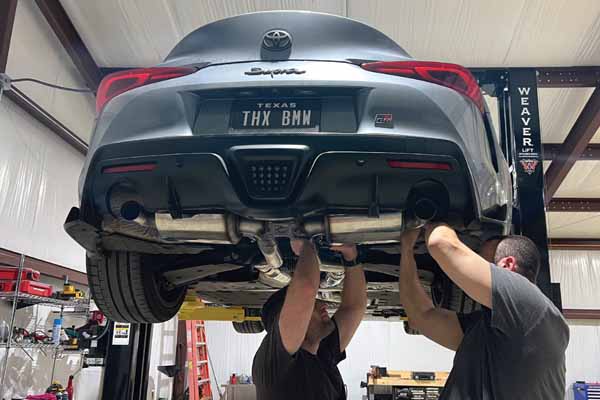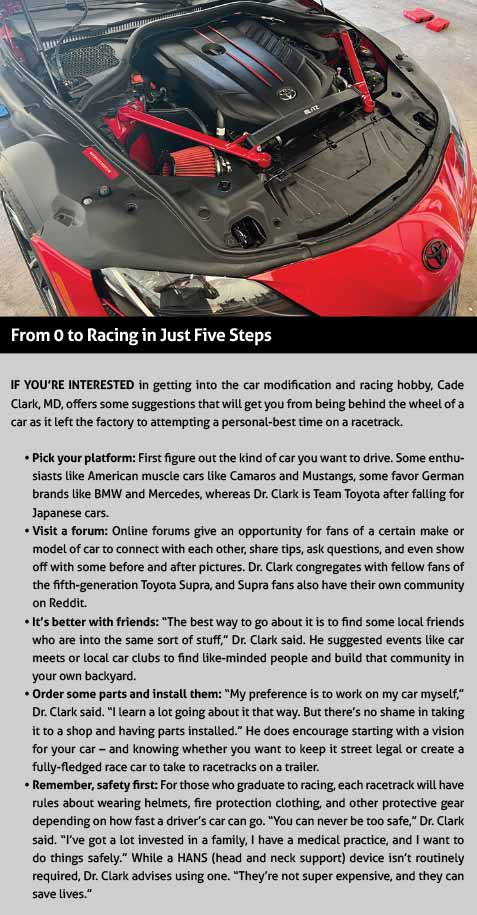
It started with lawnmowers.
Cade Clark, MD, recalls being mechanically inclined at a very young age. First fascinated by lawnmower engines, he entered the construction equipment phase familiar to many preschoolers, and by first grade, he and his friends were into cars.
“I was just infatuated with the styling of cars, the sounds of cars, the power … just ever since I can remember,” he said.
That near-lifelong love is fueling the Texas Medical Association member’s latest ambition: To take his 2020 Toyota Supra and turn it into a custom racing machine that can go a quarter mile in under eight seconds on a real racetrack.
“I just love turning a wrench,” he said. “You buy a car, and it’s mass-produced. And you think to yourself, ‘How can I make this better? What can I do differently?’”
After spending formative years in Mississippi and Oklahoma, Dr. Clark – now 34 – moved to the Tyler area and got a taste for competition playing basketball at Whitehouse High School. Upon graduation, he got his first car, a 2007 Ford Mustang GT, finding a new outlet for his drive to compete.
“At that time, it was a really, really fast car. And then, obviously, my goal was to make it faster,” he recalled. “So, I got into the modification stage of that car. I installed aftermarket camshafts, long tube headers, rear gears and a tune, all the things needed to make it competitively fast.”
Dr. Clark moved on to a Cobra, a high-performance variant of the Mustang. By then, he had friends buying cars with an eye toward modifying them, and found he liked working on their cars as well.
“I really enjoyed the mechanical process of working on the car more than I do driving or racing them,” he said, “So if any of my friends have a project going on, I’ll say, ‘Well, let’s get it in the shop.’”
Dr. Clark, a hematologist at the Baylor Charles A. Sammons Cancer Center in Dallas, sees his work as a doctor and his work on cars as similar practices, drawing on the scientific method and thinking about how multiple systems must work together.
“I actually wrote my personal statement for my application to medical school comparing human anatomy and physiology to the anatomy and physiology of our car,” he said. “There are a lot of critical components in a car that have to work synchronously and in just the right way to make the whole operate efficiently. And it’s just like the human body. So many things have to occur precisely the right way to function in harmony.”
He drives 100 miles east to Tyler whenever he can (currently, every two to three weekends) to do serious “wrenching” in a shop that his father-in-law built.
Back when he was first dating Sadie, now his wife of 10 years, he bonded with her dad, Scott Hilburn, over cars.
“He used to race a truck and a Camaro,” he recalled. “That was kind of in his family … he and I had always talked about, one day, we’re going to build a shop, and we’re going to start working on cars together. And he was finally able to build a shop on their property maybe a year or two ago, and there’s a lift in there now. And so, every time I’m in Tyler, we’re working on something.”
Or, at least, as Sadie can attest, they’re thinking about working on something.
“She’s having to pry us both out of the garage,” Dr. Clark said. “There’ll be times we’re just sitting in the garage, just looking at his truck that’s in the garage, or one of my buddy’s cars that we’re working on at the time. And we’ll just be sitting out there, just piddling and not doing much of anything.”
Becoming a Supra man
Dr. Clark was initially enamored of American muscle cars like his first two Mustangs, but then developed an interest in Japanese domestic market cars, popular with racers. When one of his two best friends bought a Supra a year and a half ago, his life changed.
“After I saw it, and rode in it, I was like, ‘Well, that’s what I have to have.’” Soon after, he and his other best friend bought Supras.
While that car is currently his “daily,” he’s already begun modifications to it, converting it to run on E85 fuel and adding drag wheels and a bigger turbo to it. He’s planning to get a truck for commuting in the near future so he can fully commit to evolving the Supra into a race car.
As a first step, Dr. Clark entered the Import Face-Off at Texas Motorplex in Ennis this past November. That racing event included a “test and tune,” which gave aspiring racers a trial run on a racetrack without the pressure of competition. He was able to get his car up to 128 miles per hour, the fastest he's ever gone in a car so far.
His initial goal for his Supra was to best a 10-second quarter mile there. By next November, his goal is getting under nine seconds at the same event.
He aims to compete in the 2026 edition of the TX2K, a Texas Motorplex-hosted annual event that draws 350 drag racers, 150 roll racers, and 40,000 fans to the racetrack every March, according to a TX2K spokesperson.
Dr. Clark will compete in drag racing, in which racers begin at a standing start, as opposed to roll racing, in which cars move in sync toward the starting line before the race officially starts. Because Dr. Clark considers drag racing to put more strain on a car, readying a car for drag racing is more challenging and therefore more satisfying, he says.
At his ultimate goal of “the high sevens” for a quarter mile, he calculates he’d accelerate from 0 to 60 miles per hour in a second and a half and might reach 180 miles per hour by the end of the quarter mile.
While Dr. Clark admits that makes him an “adrenaline junkie,” he also said, “I generally avoid other dangerous things. I wouldn’t consider myself someone to skydive or base jump or do anything else dangerous. But the feeling of being in a car that has that much power and then is capable of that degree of acceleration is … nothing else gives you that same sort of experience.”
Plus, it’s ultimately a point of pride for him to get into his Supra and be the one to race it.
“The proof of the pudding, to see if those decisions and that mechanical prowess works, is to race other people,” he said. “Did I make the car as fast as I could make it? Or is somebody else doing a better job than me?”

Phil West
Associate Editor
(512) 370-1394
phil.west[at]texmed[dot]org

Phil West is a writer and editor whose publications include the Los Angeles Times, Seattle Times, Austin American-Statesman, and San Antonio Express-News. He earned a BA in journalism from the University of Washington and an MFA from the University of Texas at Austin’s James A. Michener Center for Writers. He lives in Austin with his wife, children, and a trio of free-spirited dogs.